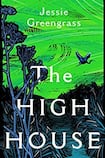
Jessie Greengrass, from first publication, has been preoccupied with our capacity to kill things or let them die. In her 2015 short story collection, An Account of the Decline of the Great Auk, According to One Who Saw It, the eponymous opening story is an extinction retrospective. A sailor remembers the years at the beginning of the 19th century when he and others wiped out a waterbird related to the razorbill. They hunted the birds for meat and feathers, burned their fat-rich bodies whole for fuel or just stamped on their eggs out of spite.
“Looking at them, at the numbers of them, you would have thought them infinite, you would have thought there could be no end to them, to their profusion.”
Characters in the English writer’s new novel, The High House, wonder at their own finite prosperity. “We had the habit of luck and power,” thinks Caro, living in a sanctuary from climate disaster, “and couldn’t understand that they were not our right. We saw that the situation was bad, elsewhere, but surely things would work out, because didn’t they always, for us?”
In the years prior to coastal regions of Britain being deluged, Caro’s step-mother Francesca, a high-profile climate activist, preached that a catastrophe would be a great equaliser. No one would escape because of their privilege. But the birth of her son Pauly awakes in her an exceptionalist instinct, and she finds herself decking out a “fortress” for his survival.
On land safe from rising tides, the “high house” is supplied with energy by a renovated mill and a generator built to run for 200 years. Francesca didn’t make it in time, instead entrusting the house to caretakers Sally and her grandfather, known as Grandy. But the residents subsist more than live. “The economy [...] between food and effort” must be factored into every choice; bathing in winter is a waste; occasionally making “horrible” bread is a luxury.
Nostalgic air
Since her 2018 novel Sight – which divided critics, and which I found to be one of the most startlingly powerful works of literature published this century – Greengrass has demonstrated a knack with long, elegiac sentences that somehow avoid sprawl as they extend.
Style for Greengrass can be a silent, long-range weapon. In The High House, it is as if she uses a future post-apocalyptic world as a perspective from which to apply the melancholy, nostalgic air of Ian Sinclair, Rachel Lichtenstein or WG Sebald to our own present.
The story is haunted by an old world that got washed away. Grandy recalls his own father’s story of meeting a sailor of the last commercial clipper routes. “Dad told me it was like speaking to a ghost [...] it seemed awful to him, how much he had watched being forgotten [...] It took him years to learn it, only for it to become obsolete. Dad told me that he had seemed, the man, as though he needed to tell someone, just so that he could be sure that the loss at least would be remembered.”
Pauly, who has no memory of his parents or sliced bread or dairy products, admits that he has “forgotten an entire world”.
Climate-affected year
This air has a slight cost. The retrospective tense and elegiac, measured tone robs the narrative of some tension and freedom to move. “There isn’t time” is a frequent refrain. “You think that you have time. And then, all at once, you don’t,” one character says to another. And yet most consequences, when they come, are felt in terms of the relief that accompanies them.
Caro worried about her parents as a teenager but “could relax” when she put them out of her mind. When Pauly hears of the death of his parents from Caro it “was a relief [...] like running full tilt into the cold sea is a relief, because afterwards you no longer have to wait for it to happen”.
The climate-affected year seems to draw out time. Grandy says: “There is no word for whatever this season is which comes, these days, between summer and autumn. I am very tired of waiting.” Euthanasia feels merciful to the reader. The sea swallows the land only after months of rain, and is in some ways welcome to the inhabitants of the house because it alleviates the tension.
But if straightforward tension exists in this world to be diffused, a sombre background static of doom is unremittingly claustrophobic. Urgency comes from the things we can already experience in the world we have, because they are in progress. The “bullet bodies” of swallows no longer seen above the water. Silent springs. Things that look most apocalyptic are just amplifications of what is happening now: “summers lasted half the year and every day was a white sun in a pale sky”.
You think that you have time. And then, all at once, you don’t.











